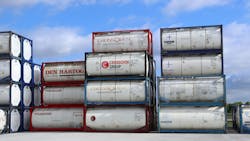Trade, tech, and tanks: ITCA tackles challenges in liquid bulk transport
Key Highlights
- Trade tariffs are intended to promote reshoring but initially increase costs for chemical importers, squeezing margins for mid-sized specialty chemical companies.
- Houston Ship Channel's expansion and infrastructure upgrades are critical to supporting the growing liquid bulk and petrochemical industries, with ongoing investments planned.
- Enhanced hours-of-service compliance and technology adoption are vital for bulk haulers to improve safety scores, reduce violations, and stay competitive.
- AI introduces operational risks such as fake documents and cyber-attacks, requiring companies to develop awareness, training, and contingency plans.
KEMAH, Texas—The Trump administration’s highly fluid trade policies will increase domestic chemical manufacturing in a boon for liquid bulk haulers, but only if the next administration stays focused on reshoring industrial production, Ron Beeson, a longtime transportation manager for Lubrizol, said during the Intermodal Tank Container Association’s 2025 Intermodal Bulk Liquid Symposium. That’s because establishing new manufacturing facilities and sourcing partnerships takes time—and the long-term gain comes with short-term pain.
“The intended goal with these tariffs is to reshore manufacturing, grow the U.S. economy, and protect the domestic industry, but in the short term the impact is on the imported chemicals and intermediates specialty chemical companies rely on, where there is no domestic purchasing option, and that is a significant net price increase,” Beeson observed.
“So, we’re in a dynamic situation and margins are getting squeezed.”
Mid-sized specialty chemical providers are feeling the most pain because they’re more likely to have a single-source supply, and their larger petrochemical partners are more likely to push back on attempts to pass on tariff-induced price increases, Beeson added. Still, he insists, the administration’s disruptive stance is desperately needed, a sentiment supported by warnings emerging from the European Petrochemical Association’s 59th Annual Meeting about Chinese companies dumping chemical materials into world markets at or below cost in a bid to secure long-term gains that threatens the viability of the European chemical industry.
“They said, “Well, it sure is nice that America and President Trump are taking a stance to address the situation,’” Beeson said.
“And Europe probably is more exposed than the United States.”
ITCA’s 21st industry reunion Nov. 13 at the Sundance Grill also included updates on the growth of the Houston Ship Channel, which supports the largest petrochemical complex in the country; strategies for maximizing hours-of-service efficiency and compliance; tips on strengthening cyber resilience in the AI age; and certificates of appreciation for supporting ITCA and advancing intermodal tank container safety awarded to more than a dozen chemical shippers, including Ascend Performance Materials, Baker Hughes, Dow, Huntsman, Ineos, Invista, Nouryon, and Oxea.
Petroleum-powered port growth
Last year, the Port of Houston moved a record 53 million tons of cargo in a 6% year-over-year surge, Andy Pan, Port Houston trade development manager, reported—and 71% of the cargo in the 52-mile Houston Ship Channel is liquid bulk. Houston’s port also leads the United States in exports of resin—with a 60% market share—and petroleum and petroleum products.
“We are a crucial engine,” Pan said. “We support over 1.5 million jobs here in Texas and over 3 million jobs across the nation. The economic impact is close to half a trillion dollars in Texas alone and, as of today, over a trillion in the U.S.”
That’s why Houston’s port authority is investing heavily in upgrading and expanding infrastructure in and around the ship channel, which boasts over 200 terminals and 500 million barrels of bulk liquid storage capacity. Port Houston poured $2.4 billion into improvement projects over the last five years, including rehabilitating wharves and yards, expanding container storage space, deploying new cranes, and widening the channel by 170 ft. to improve traffic flow. “And, of course, we’re planning to spend another $1.9 billion in the next five years to further expand and grow our operation and infrastructure,” Pan shared.
A top focus now is on leading the charge to improve the roads and bridges that lead in and out of the port, including State Highways 146 and 225.
“We’re already working with the Texas Department of Transportation, Harris County, and other authorities, and we’ll probably ask all of our stakeholders for help as we advocate for expanding the roadways,” Pan said. “Because no matter how efficient we are, or how fast we can move your tank containers in and out, it isn’t doing anyone any good if they’re stuck on the road.
“So, this is something we all need to pay attention to.”
Unlimited HOS advantages
The Federal Motor Carrier Safety Administration will soon launch a new Compliance, Safety, Accountability (CSA) enforcement program, which the agency says will enhance the fairness, accuracy, and clarity of its safety management system. While tank truck carriers wait to see if that’s true, they can improve their CSA scores now by paying closer attention to one of the current CSA Behavior Analysis and Safety Improvement Categories (BASICs)—hours-of-service compliance.
“Hours-of-service violations contribute directly to your CSA scores, and those scores contribute directly to the cost associated with running your business,” said Justin Sanders, a safety consultant and log auditor with Transafe, a Houston-based transportation safety firm. “Poor CSA performance also leads to audits by federal and state agencies. If you have a high score in one BASIC, you’re on the radar. If you have two or more, go ahead and get ready for an inspection.
“They’ll probably come see you in the next three to six months.”
Common HOS infractions include exceeding the 11- and 14-hour driving limits, falsifications such as misuse of the exemptions for personal conveyance or adverse driving conditions—traffic isn’t an adverse condition, Sanders noted—and form-and-manner exceptions like incomplete paperwork. But while limitations and technicalities are easy to monitor and correct, falsifications are harder to detect, and often don’t come to light until pre-trial discovery.
“You really want to make sure you have a process in place to identify and eliminate falsifications,” Sanders advised.
Carriers should create written policies and procedures that establish expectations, incorporate HOS compliance and ELD operation into training programs, leverage tracking and telematics technologies, and promote clear communication about route planning and real-time circumstances between drivers, dispatchers, managers, and even salespeople. And, in addition to mitigating CSA violations, expert implementation of expectation management, compliance monitoring, and corrective action helps carriers survive and thrive by keeping rising insurance premiums in check and unlocking new opportunities in a competitive environment.
“You can turn something that seems like a limitation into an advantage if you do it better than everyone else,” Sanders concluded.
Balancing AI risks and rewards
Artificial Intelligence promises to reward businesses with gains in efficiency and optimization. But this rapidly evolving technology also introduces new operational risks as users learn the hard way what not to share with AI agents, and bad actors develop AI-enabled methods for subverting systems.
“They already have the ability to create false documents—ranging from clearance documents and MSDS sheets to anything else you use in the process of moving or shipping products,” said Jeff Miller, the manager of security incident response operations at Autodesk who previously worked in cyber-crisis management at Bp and Eaton. “They can do that today. They can also initiate fake phone calls. So, they can already do all sorts of things [utilizing AI] to misrepresent you and divert your commercial vehicles through those actions.”
Effective counters include cultivating an awareness of AI-powered attacks, training employees on detection, securing sensitive communications, and setting up continuity plans that include contingencies for dealing with digital disruptions like the recent outages on cloud platforms Amazon Web Services and Microsoft’s Azure, and internet services provider Cloudflare—all since Oct. 20.
“What happens if a cyber or non-cyber incident occurs and you can’t access those systems, but you still need to get trucks down the road?” Miller said. “What is the manual process you must follow to make that happen? That’s the convergence where we need to understand the core processes that keep the business running, and how we back into the IT systems that control them, so we ensure there is a certain level of investment in crisis management, and we can quickly restore those applications and continue to make money for the business.
“Those are the key elements I see that need to be fleshed out across industries over the next 12 to 18 months, because we are so interdependent when it comes to our technology, especially in the global supply chain—and one disruption in the space has a domino effect.”
About the Author
Jason McDaniel
Jason McDaniel, based in the Houston TX area, has more than 20 years of experience as an award-winning journalist. He spent 15 writing and editing for daily newspapers, including the Houston Chronicle, and began covering the commercial vehicle industry in 2018. He was named editor of Bulk Transporter and Refrigerated Transporter magazines in July 2020.





